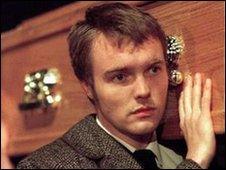Telling the story of Bloody Sunday
- Published

The story of Bloody Sunday has been told, and retold, many times and in many ways since 30 January 1972.
Singers, songwriters, playwrights, poets, novelists, artists and filmmakers have all created their own interpretations of what happened that day, making "Bloody Sunday" an instantly recognisable phrase.
In the 1980's, U2's "Sunday Bloody Sunday" made the Bogside familiar to a worldwide audience - and linked the 13 deaths to a global call for peace.
For artists from John Lennon and Paul McCartney to Christy Moore and the Wolfe Tones, Bloody Sunday was the catalyst for anti-Troubles songs, while playwright Brian Friel modified his 1972 play 'Freedom of the City' - set in Derry's Guildhall - to include references to Bloody Sunday.
More recently, two 2002 films - Paul Greengrass's "Bloody Sunday" starring James Nesbitt, and "Sunday", written by Jimmy McGovern - brought the events of 30 January 1972 to cinema and TV.
The co-producer of "Sunday" and the director of Gaslight Productions in Derry, Stephen Gargan, says the story of Bloody Sunday was one that had to be told.
"We wanted to communicate the local truth about Bloody Sunday to a wider audience.

Leo Young, played by Ciaran McMenamin, carries his brother John's coffin in the film 'Sunday'
"I think the film made, and continues to make, a contribution to telling that story and communicating that story to a wider audience.
"In particular, I think we tried as best we could within the confines of television to humanise the people who were killed that day, and to give the wider public a better understanding of the impact on families and on communities when a loved one is taken from them.
Poignant
"Myself and Jimmy McGovern, who wrote the script, initially started with the families and then moved out to the surviving wounded and then witnesses and IRA members, and we had a parallel research team running in England talking to former British soldiers and other personnel, so the script was very much grounded in fact.
"But beyond that we were trying to get to an emotional truth and a factual truth, and I think that's the power of a drama documentary, in that it can communicate that emotional truth."
One of the most poignant scenes came during the filming of the funerals.
"It was a very cold night, and we had all the coffins laid out and people started to carry them towards St Mary's church.
"The individual families actually formed up behind their own particular coffin, and in some parts helped to carry them, and if you look at the scenes now you do see actual family members in them.
"I think they felt themselves that they were making a contribution to their own family's story," he said.
More recently, the Saville Inquiry into the events of Bloody Sunday has itself become the focus of artistic interpretation.
Imperieum
The Tricycle Theatre - which previously staged a reconstruction of the Stephen Lawrence Inquiry - brought Saville to the London stage. The production was later adapted to make a BBC radio drama.
In Derry, Dave Duggan's "Scenes from an Inquiry" portrayed about what he called, the "greater human experience of the Inquiry".
"The layout of the Guildhall and the equipment they had, the money they had, and the suits and the boots and the accents, the way they were seated and the way they spoke, the permission that had to be gained in order to say or not to say, and the conflict between the counsel and the witnesses and the judges... The Imperium had arrived in one of the provincial cities and it just spoke theatre to me.
"I also felt that one of the impacts of the Saville Inquiry was a narrowing of the language into a very narrow legal discourse, and I kept feeling there would be opportunities for expanding that."
"The legal process is vital and essential, but I think there are other processes, in particular those that use the imagination, that can assist in a wider salving of the hurts that an event like Bloody Sunday has left with individuals and the community."